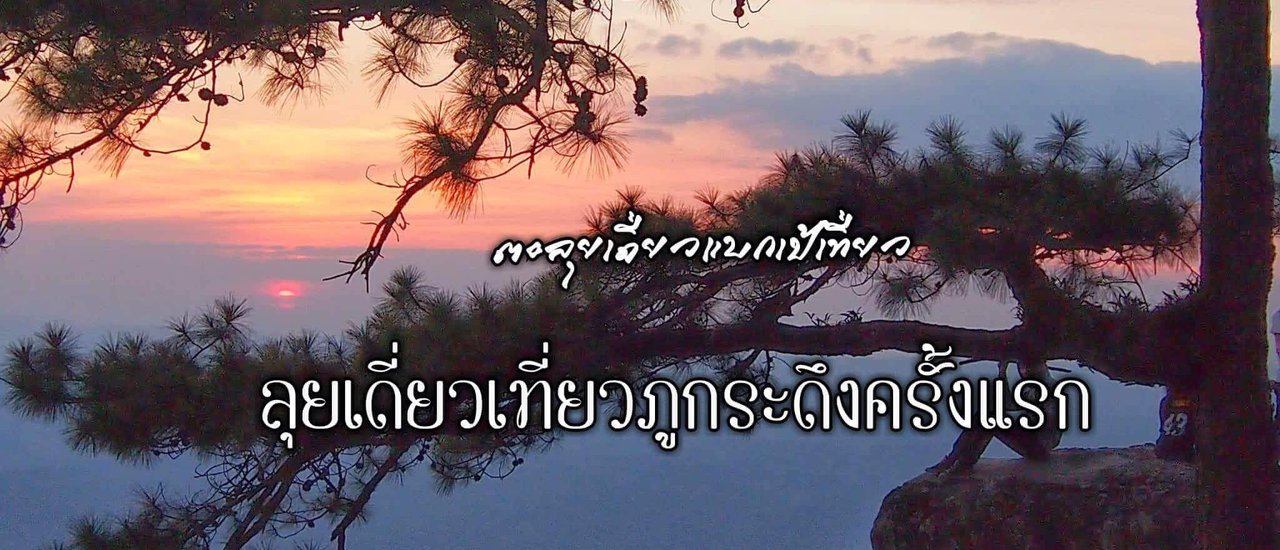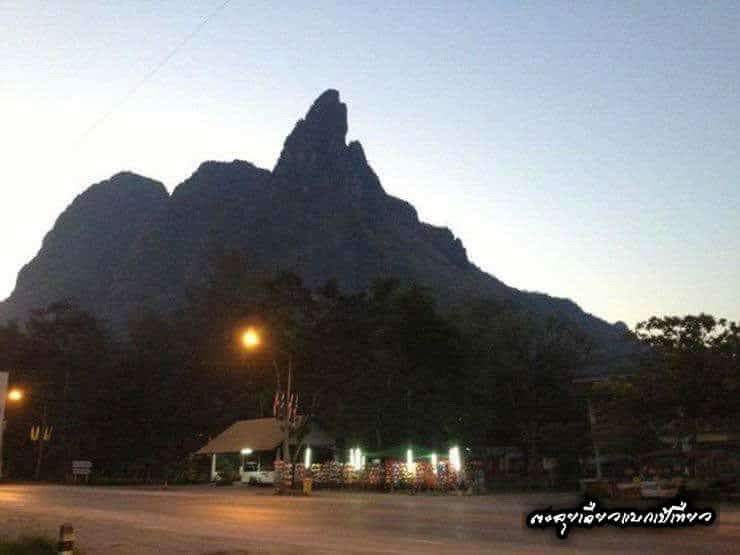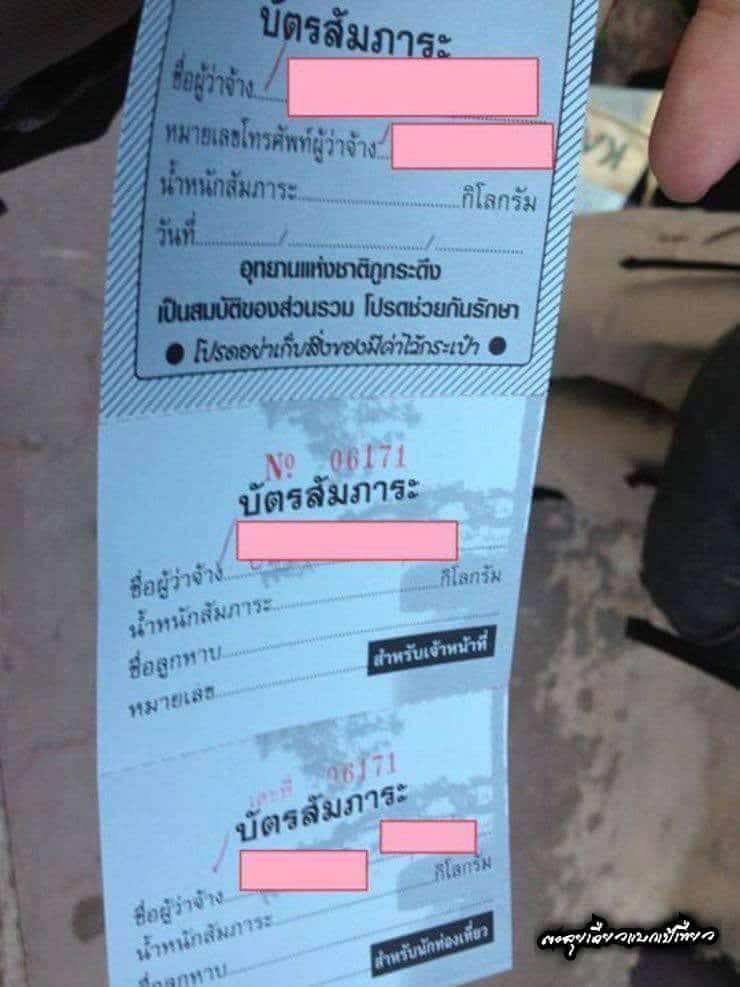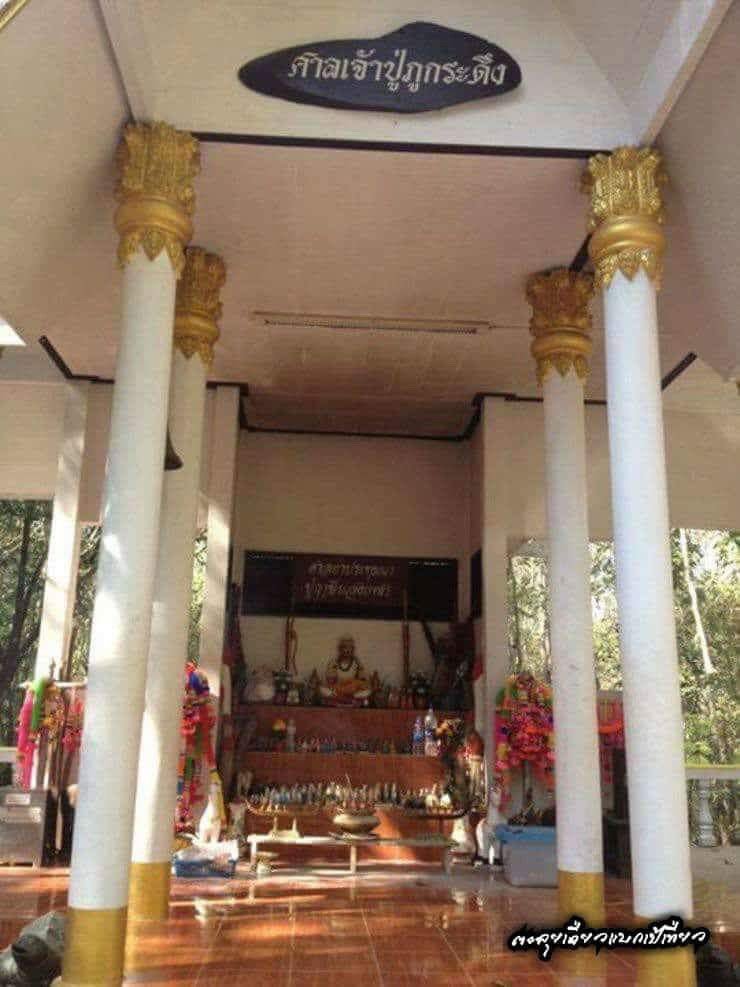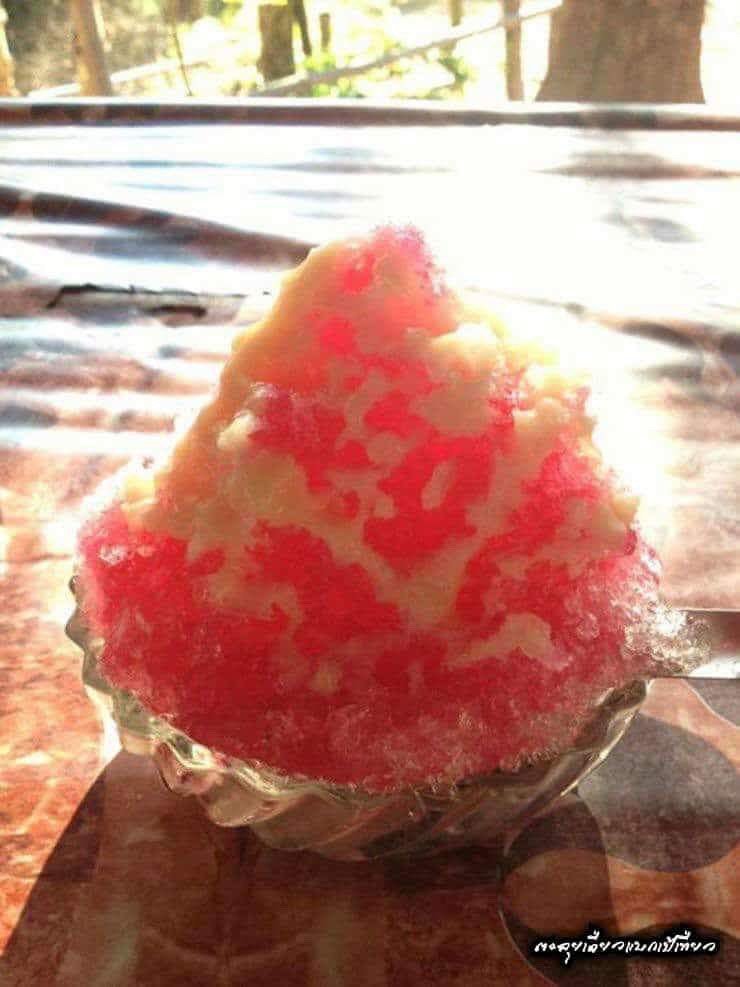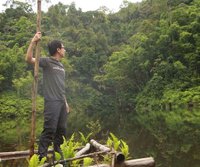This trip was from December 2012. I'm bringing back old photos and posts to share during the opening of Phu Kradueng National Park. I think it might be helpful for beginners. All photos were taken with a mobile phone, as usual.
I had always wanted to visit Phu Kradueng before I got too old and couldn't make the trip. So, I made a spur-of-the-moment decision to go. My first step was to research travel options, hiking trails, accommodation, food, and popular tourist attractions on Google. Once I had some basic information, I packed my bags. As usual, I only brought one backpack, unsure if I would need to carry it around like I always do on my travels. I decided to travel on a weekday, hoping there would be fewer people. I left Bangkok on the evening of Wednesday, December 19, 2018.
Travel Information
We opted for a bus journey, believing it to be the most economical and expeditious option. Departing from Mo Chit 2 and arriving at Pha Nok Khao (the parking area for those ascending Phu Kradueng), numerous companies cater to diverse preferences, including Air Mueang Loei, Phu Kradueng Tour, BKS, and Sun Bus (five years ago, only Air Mueang Loei and Phu Kradueng Tour were available). We selected Air Mueang Loei due to its latest evening departure at 22:35, arriving at Pha Nok Khao around 6:00 to minimize waiting time (estimated travel duration: 7 hours).

The first fear that struck me as the bus emptied was the large crowd. Stepping into Jeh Kim's shop, I was met with even more people preparing to ascend Phu Kradueng. My initial instinct was to return home, as I dislike being surrounded by large crowds. However, I reasoned that since I had already arrived, there was no point in turning back. We decided to refuel with some curry rice. Jeh Kim's food is delicious, but eating curry rice at 6 am was a bit much. After a few bites, I felt full. We rushed to the bathroom and then carried our backpacks to the waiting songthaew. We opted to share the ride with others, thinking it unnecessary to pay for a private ride since we were traveling light. For those who prefer a private ride, the cost is only 300 baht. However, if you share the ride, the fare varies depending on the number of passengers. With ten passengers, the cost was 30 baht each. The early morning ride in the songthaew was freezing, the wind chapping our lips. After about 30 minutes, we arrived at our destination.
Note: The original text is empty, so the translation is also empty.
Tourist Service Center Sri Than, Phu Kradueng National Park
The first stop is the luggage storage, as it is unclear whether we will be able to carry our belongings to the top. The first thing to remember for first-time visitors is to purchase a luggage tag for 5 baht.

Note: The original text is empty, so the translation is also empty.
Fill out the provided details and join the queue for weighing. You will receive a baggage claim ticket for each bag you entrust to our porters. Each bag weighs 5 kilograms, and the current porterage fee is 30 baht per kilogram. You can pay upstairs upon receiving your bags. Then, return to the Tourist Service Center to pay the park entrance fee, which is currently 40 baht. If you haven't brought your own tent, you can rent one here. If you have brought your own, you will still need to pay the tent pitching fee here. Finally, if you need to use the restroom again, there are facilities available. Continue walking, and you will find a designated spot for taking photos with the sign "Once in a Lifetime, Conquer Phu Kradueng."


Upon arrival, novice hikers should pay their respects at the Phukradueng Shrine, located to the right of the entrance gate manned by officials. This gesture of respect to the local spirits is believed to bring good fortune and a safe journey.

We started our ascent at 7:50 AM, accompanied by a large group of high school students on a field trip. The students were loud and excited, taking photos and enjoying themselves. Their energy was contagious, and we found ourselves having fun as well. We followed the students as they hiked up the mountain, covering a distance of 5.5 kilometers. The initial chill soon gave way to sweat as we climbed higher. Despite feeling exhausted, we decided against taking a break, as sitting down immediately after exertion could lead to cramps. Instead, we continued to follow the students, eventually reaching a steep section. After climbing for a while, we arrived at "Sam Haek."
I understand now. The hack is real. We arrived at 8:10 AM. We decided to continue walking. We started overtaking several groups of children. We reached "Sam Bon" at 8:29 AM. We continued walking for a while and reached "Sam Khok Khok" at 8:34 AM. We continued walking to "Sam Ko Sang" at 8:40 AM. We decided to stop for a cup of shaved ice. It wasn't too expensive, only 20 baht.

Leaving the shop at 8:53 AM, we arrived at "Phra Phran Pae" at 8:59 AM. During this section, there was a walkway with iron railings to hold onto. We saw children taking a path without railings, so we followed them, climbing up and down. It was a straight path that led directly up, with some sections requiring us to climb over the iron railings. This allowed us to reach "Sam Kok Wa" quickly at 9:07 AM. We continued on to "Sam Kok Phai" at 9:16 AM and "Sam Kok Don" at 9:24 AM, overtaking all the children. There were only porters and 2-3 adults left. After a while, we reached "Sam Krae" at 9:33 AM. Then we had to climb again, the path was very steep, and we had to give way to the porters (if you see it, you will understand why we had to give way to the porters). We timed ourselves because we wanted to know how much energy we had left, not to compete with anyone. We were competing with ourselves.

Upon reaching "After Pae" at 10:15 AM, I was greeted by another sign for the conquerors of Phu Kradueng. Fortunately, as a frequent solo traveler, I was able to use the front camera to take a picture of myself. After a moment of confusion, I figured out which way to go. I followed the porters, who were now pushing carts instead. Despite my earlier fatigue, I was now intoxicated by the excitement of taking pictures and enjoying the scenery. The distance from After Pae to the "Wang Kwang Tourist Service Center" is 3.5 kilometers. Fellow travelers who were on their way back encouraged me, saying that I was almost there. This is the kind of camaraderie that comes with travel. I arrived at the Wang Kwang Center at 11:05 AM, the second person to do so. It took me 2 hours and 25 minutes to get from Sri Than to After Pae, and 50 minutes to get from After Pae to Wang Kwang.

Tent Selection
The staff was very informative. They told us to choose our tent first before renting bedding. If we wanted a quiet spot, we should choose the back area. If we wanted comfort and no leeches, we should choose the front area, but it would be crowded and noisy. We looked around for a while and finally found a tent in a quiet area away from the crowds. However, the staff warned us that there were many leeches in that area. We decided to go with the quiet spot anyway. After choosing our tent, we closed it up (the staff told us that closed tents meant they were already reserved). We then walked around waiting for our luggage, feeling very hot and wanting to take a shower.

Garbage disposal
Waste disposal facilities are conveniently located around the campsite and along the hiking trails on Phu Kradueng National Park.
Food and Cuisine
There are many restaurants on the top floor. The first time I went, I didn't know where anything was, so I walked around before sitting down to eat tom yum noodles (I don't remember the name of the restaurant). The price was the same as all the other restaurants, 60 baht, but they sold Coke for 40 baht and a large bottle of water for 60 baht, so I only ate there once. After that, I ate all my meals and bought everything at the shop run by Joe and Yuth (Chwang, Nakhon Si Thammarat). They were very kind. The single dishes were also 60 baht like the other restaurants, but the portions were more than enough. Coke was 30 baht and a large bottle of water was 50 baht. All the restaurants offer free hot tea because it is very cold. If you come with a large group and want to eat moo kata, it is also good. It is fun and warm. The price is 300 baht for a small set and 500 baht for a large set. All the restaurants have the same prices.
Collect luggage and pay the porter.
Luggage delivery to tents is unavailable. Please collect your luggage at the designated baggage claim area. The porters are unaware of your tent location. Payment has been made to the porters. Please express gratitude and avoid resentment for any delays in receiving your luggage.
Restrooms and Toilets
There are many service points available. Choose the one closest to you. When using the shared bathrooms and toilets, please help keep them clean as the staff may not be able to keep up with the cleaning. One thing to note is that the water is very cold, so be prepared for a shock! However, if you stay for several days, you will adjust. We stayed for 4 days and 3 nights and were comfortable. However, we saw a sign that they are installing water heaters. This is because the park has installed additional solar panels. (As of our last visit, there were still no water heaters as the electricity could not keep up with the increased usage by tourists.)
Charging mobile phones and cameras
The park has well-organized charging services at the tourist service center. The fee is 20 baht per charge, with a maximum charging time of 2 hours. The service is available from 5:00 AM to 10:00 PM. Overnight charging is not available. Please be patient during peak hours and avoid confronting the staff. Alternatively, you can charge your devices at some restaurants, some of which offer free charging with consumption.

Tourist Attractions
The duration of your stay at Phu Kradueng National Park will determine your sightseeing experience. During our four-day, three-night stay, we were able to visit all the attractions listed on the information board at the tourist service center. Additionally, we were granted access to the closed forest as a bonus.
Day 1
Pha Mak Duk: A Breathtaking Viewpoint in Khao Yai National Park
Pha Mak Duk, located 2.3 kilometers from the tourist service center, boasts a spacious stone platform offering stunning views of both sunrises and sunsets. Between November and February, visitors can witness the breathtaking panorama of Phu Pha Jit within Khao Yai National Park. During the early rainy season, the path leading to Pha Mak Duk transforms into a vibrant carpet of blooming ginger lilies. The serene atmosphere makes it an ideal spot for sunset viewing. Additionally, there are shops available for refreshments. Visitors are advised to bring a flashlight and warm clothing.


Pha Chamsan is located 600 meters from Pha Mak Duk. It is a small cliff that is also suitable for watching the sunset, but it is not very popular.

Day Two
Nakaen Cliff
Nakaen Cliff is located approximately 2 kilometers from the Wang Kwang Tourist Service Center and 2.5 kilometers from Lang Pa. It is a small rock platform with a lone pine tree standing prominently at the edge of the cliff. This spot offers a breathtaking view of the sunrise, with fresh, cool air and panoramic vistas of the plains and mountains below. From here, you can clearly see Pha Nok Kao. Along the path leading to Nakaen Cliff, there is a rock garden with a large patch of wild roses that bloom profusely in March and April. Visitors planning to witness the sunrise at Nakaen Cliff should bring a flashlight to illuminate the path.

The provided text is empty. There is nothing to translate.
Emerald Buddha Temple Ground After watching the sunrise at Pha Nok Aen, the staff will take you to the Emerald Buddha Temple Ground, which is only 500 meters away. It is the location of a Buddha statue built in 1920. The spacious stone courtyard is home to various flowering plants such as Dusita and Eulophia orchids, which bloom abundantly across the ground during the late rainy and early winter seasons.

Today's hiking route takes us along the waterfall and back along the cliff edge. Food and water are essential for this route as there are no shops along the way.
**Wangkaw Waterfall:** Located just 750 meters from the starting point near the park's bungalows, this waterfall features a 7-meter-high rock cliff that cuts across the stream. The water flows into a pool below, resembling a cave opening. The nearby forest is home to a herd of deer that frequently come down to drink water, hence the name "Wangkaw" (meaning "deer pool"). The area around the waterfall offers ample space for relaxation with multiple seating areas. Due to its close proximity, visitors can enjoy swimming in the waterfall's pool.

Puen Pob Mai Waterfall is located 1.6 kilometers north of Wang Kwang Waterfall. It is a waterfall that flows over a curved rock cliff with a height of 8 meters, cascading into a pool below. During the winter season, bright red maple leaves fall and float on the water's surface, contrasting with the green moss on the rocks. This makes it a popular spot for photography. We spent a considerable amount of time here, enjoying climbing up to take pictures at various points.


Phonopphabha Waterfall is named after Phonopphabha Kengpech, the first Thai world champion boxer, who discovered the waterfall while training for a fight in a cold climate. It is one of several waterfalls fed by the Wang Kwang River, located just 558 meters from the Penพบใหม่ Waterfall. The waterfall cascades down a series of rock steps, resembling a staircase. The upper stream of the Phonopphabha Waterfall offers a scenic view of the waterfall from the middle of the stream. The waterfall has 8 tiers and is approximately 30 meters high, making it one of the larger and more beautiful waterfalls on the mountain. The name "Phonopphabha" means "Phonopphabha found it".

Penพบ Waterfall
Located south of Phorพบ Waterfall, Penพบ Waterfall is a three-tiered cascade that plunges 342 meters into a large pool below. Birds are often seen playing in the water.

The Grand Cave Waterfall: A Hidden Gem in the Forest
The Grand Cave Waterfall, located approximately 1.4 kilometers from the Phaeng Phob Waterfall, is a hidden gem nestled within a dense, primeval forest. This trail boasts the most extensive and diverse collection of towering trees compared to other waterfall paths. As you venture along the Grand Cave route, you'll encounter sections where the path follows a small stream, adorned with maple trees scattered throughout. During early January, the trail transforms into a breathtaking spectacle as fallen maple leaves paint the forest floor in vibrant shades of red.
The Grand Cave Waterfall's unique beauty lies in its chaotic arrangement of massive boulders, creating a mesmerizing cascade. The stream is flanked by maple trees, which, during their autumnal descent, paint the green rocks with vibrant hues, adding a touch of life and vibrancy to the landscape. The maple leaves here are particularly large and stunning, further enhancing the visual allure of this hidden gem.


Thar Sawat Waterfall: Not far from Tham Yai Waterfall, as you enter the pine forest, there is a fork in the road on a rocky plateau leading to Thar Sawat Waterfall. It is only 1.6 km from the accommodation along the pine forest path, passing the Lan Ong Phra Phutthametta. This is a small, peaceful waterfall that few people pass by, as beyond it is a closed forest area. We chose to stop and eat lunch here, sitting on the edge of a cliff under a tree with a constant breeze. There are also maple trees here, which were already starting to turn red. We took a nap here after lunch, feeling very relaxed.

Ano-Nong Lake is located 3.4 kilometers from the tourist service center. It is a natural lake with water all year round. Two-leaved and three-leaved pine trees grow around the lake. Nearby, there is also Lan Kinnaree, a natural rock garden rich in various plants, including carnivorous plants such as Dusita, Drosera, or ferns such as Lion's Mane Fern. The rocks are also covered with lichens.


Soi Nuea Waterfall is located 5.7 kilometers from the Wang Kwang Tourist Service Center. The waterfall is 10 meters high, with water cascading over rock slabs and plunging into a large boulder below. Above the waterfall, there is a grove of red roses that bloom in the summer, adding color and beauty to the area. This is a waterfall that we almost went swimming in because it was so peaceful and quiet, with hardly any people around.

Soi Tai Waterfall is located approximately 500 meters downstream from Tham Soi Nuea Waterfall. The waterfall cascades down a high cliff, passing through rocky outcrops before plunging into a pool below, surrounded by beautifully arranged boulders. We attempted to follow the stream down, but we switched to walking on top and climbing down to the waterfall, which proved too challenging. The incline is quite steep, and going alone requires extra caution as no one would know if you went missing.
Pha Lom Sak is a must-visit landmark on Phu Kradueng Mountain. Located approximately 9 kilometers from the park headquarters, it features a vast rock platform with a lone pine tree clinging to the edge of a cliff near a rocky outcrop jutting out into the air towards the south. Pha Lom Sak offers breathtaking views of the mountainous landscape of Phetchabun province and is a prime spot for witnessing spectacular sunsets. Visitors planning to watch the sunset at Pha Lom Sak should bring warm clothing and a flashlight for the return journey to their accommodation, which typically takes 2-3 hours. We forgot to bring warm clothes, so we had to walk-run back, completing the journey in just 1 hour and 15 minutes. It was freezing! The temperature dropped significantly as soon as the sun set.


Day Three
Swallow's Crag witnesses the sunrise once again, but this time the sun's position has shifted from the left to the center and then to the right.

Note: The original text is empty, so the translation is also empty.

The Emerald Buddha Temple courtyard, where visitors can pay respects to the Buddha statue once again.

We rushed to the tourist information center to inquire about entering the closed forest. Luckily for us, there was a ranger available to guide us. We quickly prepared our lunch and water. The ranger informed us that we needed to wear long pants and closed-toe shoes, as the trail in the closed forest involved climbing up and down. The round-trip distance was only 15 km, which wasn't too challenging. We had 12 companions and one ranger with a long gun and a short gun.
Phra Phutthametta is located approximately 500 meters from the campsite, within easy walking distance. The path is lined with pine trees. The park rangers led us to pay our respects before guiding us into the closed forest.

Note: The original text is empty, so the translation is also empty.
The Tharn Sawan Waterfall is the easiest route to access the closed forest. Park officials informed us that this is the most accessible path due to the presence of a park vehicle road used for creating firebreaks.
The trail began as a dirt road, quickly becoming overgrown with seasonal vegetation. Pine forests and tall grasslands followed, making the path increasingly difficult. The rangers kept us close, as the risk of getting lost was high. We spent a considerable amount of time walking in the initial section before stopping to check for leeches on our pants and shoes. We then entered an area frequented by wildlife, evidenced by numerous footprints of barking deer, deer, wild boar, wolves, hyenas, and elephants. Animal droppings were also visible along the way. Upon reaching the highest point overlooking the cliff, the rangers allowed us to rest and admire the scenery. This included the Pha Nam Pha waterfall, the cascading waterfall, the Great Wall of China (a sheer rock face resembling a wall), and the Pha Song Lok (a name we had heard for a long time; we will inquire about the possibility of visiting it next time, although we understand it is currently off-limits). The rangers surveyed the path we were to descend, as it was a wildlife foraging area with a high chance of encountering large predators. We then began our descent through a seemingly easy but challenging gorge. Our first stop was a clearing with a peculiar-looking waterfall (we will ask for more details on our next visit). We continued our trek, enjoying the low water levels, which the rangers hoped would be replenished by heavy rains before the new year (we wonder if there is still water now?). As we walked along the headwaters, we eventually reached...
**Hongsathon Waterfall** is surrounded by maple trees, with the smallest trees located closest to the viewing area. Visitors can take photos at this location. Park rangers have reported that during particularly cold years, the waterfall is adorned with falling red maple leaves, creating a stunning visual against the backdrop of green moss-covered rocks. After enjoying the photo opportunities, visitors can relax and enjoy the cool breeze.

After admiring the Hong Thong waterfall, we set off on a hike into the forest. This time, the path was rocky and not too difficult to walk, but we had to climb and duck under trees, which was fun. After a while, we passed maple trees, all kinds of mushrooms, and various flowers until we reached...
Khun Pong Waterfall is a large waterfall with abundant water even during the dry season. It is truly beautiful. Everyone enjoyed taking photos in their own style. The park rangers allowed us to have lunch here, and everyone found their own spot. We walked to the corner behind the boulder closest to the waterfall and sat down to eat our lunch, accompanied by the sound of the waterfall and the mist that blew in. After we finished eating, we took a long nap.


We continued our hike, taking a more challenging route to the other side of the mountain to reach the source of the Khun Pong waterfall. Along the way, we encountered oddly shaped rocks that provided excellent photo opportunities. Feeling adventurous, we ran along the stream, jumping into the forest on the side and venturing further until we discovered two more unnamed waterfalls branching off from the main one. Time constraints forced us to return quickly, not wanting to keep the others waiting.

The return journey was filled with excitement as we walked through the wildlife sanctuary, where silence was mandatory. We listened intently to every sound, walking in a single file without any gaps. The path led us through tall grasslands, adorned with our favorite wildflowers. Soon, in the quietude, we reached a point where we had to climb a hill again. Everyone climbed silently until we reached the top, where we began to chat animatedly. By now, everyone had become closer and more talkative.



After resting until our sweat dried, we continued walking, passing back through the same path. We were in the first group, and the suspense arose when we heard the sound of an animal walking through the grassland on the left side, passing us in front. The three of us in the leading group stopped and listened to the sound. The officers began to ask what had happened, and the guns were prepared if necessary. All of us stopped moving, listening to every sound around us. After a while, the officers told us to walk as fast as we could and meet them at the firebreak at the junction to Pha Daeng (4 people wanted to continue to Pha Lom Sak). When we arrived, we separated for a while. We walked back the same way. The way back did not make it easier to walk. The path was still dense with various plants. Until we reached the exit of Tharn Sawan Waterfall, we learned that the sound we heard was that of a wild elephant (2 other officers followed us in to investigate and ran away from the elephant). We sat and rested at Tharn Sawan Waterfall before returning to the camping ground and parting ways with the friendship that arose from the trip.
Day Four
We had to return home that day, so we packed our belongings, took a shower, and left our bags with the porters. They informed us that we would receive our bags at 3 pm. It was only 8 am, but we left them anyway. We decided to continue walking uphill. Initially, we planned to visit only two places: the Phra Phuttha Metta and the Sa Kaeo Reservoir. However, there were many more attractions to explore.
Lord Buddha's compassion We pay our respects before returning home.


Sa Kaeo, located 1 kilometer from the Wang Kwang Tourist Service Center, lies at the headwaters of the Tharn Sawan stream. This "heavenly stream" features deep, narrow pools with crystal-clear water, revealing a clean, white rock bottom. It serves as a vital water source for numerous wild animals.

The sentence is already in English and does not require translation.
Following the Emerald Pool, a nature trail leads through a rocky clearing dotted with fields of violet-blue, yellow-centered wreath flowers, extending to the Lesser Cliff. A left turn reveals the Meditation Cliff, offering a spacious rock platform for rest. Approximately 600 meters from the Meditation Cliff lies the Betel Nut Cliff. Alternatively, a right turn leads past the Cloud-Treading Cliff and the Red Cliff, culminating at the Mortar Cliff. Opting for a shortcut along the cliff's edge to avoid retracing our steps, we stumbled upon an unexpected bonus.
Little Rock: We walked for a long time, about 2 kilometers, before reaching Little Rock. As with all the cliffs, there are shops here, two in this case.


Cloud-Kissing Cliff
Located approximately 2 kilometers from Pha Nanoi, Cloud-Kissing Cliff is a remarkable rock formation that juts out from the cliff edge, offering breathtaking views. The sheer height of the cliff is awe-inspiring, and we spent a considerable amount of time admiring its grandeur.



Red Cliff is about 1.5 km further on. It is the last cliff we intend to visit because we have already been to Sak Sinkhole. When we arrived, we took photos.


The return journey requires traversing the same cliff edge, passing by Pha Hieab Mek, Pha Na Noi, Pha Jam See, Pha Mak Dook, and finally, Pha Mesa.
Mesa Cliff is located approximately 500 meters from Mak Doo Koo Cliff. It is a prominent cliff that juts out significantly. At the very end of the cliff face, there is a large footprint-like mark. Gold leaf has been applied to the area around the toes, making it more visible. We spent a considerable amount of time at this location.


I then hurried to the back of the hut to take a picture before descending. I stopped by the bathroom and started my descent (I must say, I don't like descending at all. It's both tense and requires me to dig my feet in for fear of slipping). Looking at the time, it was already 1:17 AM. I'd better hurry down to catch up with the porters. I continued my descent without rushing, but it was torture. My feet were constantly tense, and I dug them in so much that they hurt (when I got home, my little toe was bleeding). I didn't stop to rest at all, but I did step aside for the porters and chatted with those who were climbing up cheerfully. I caught up with our porters at Sam Haek, and I overtook them on the way down. I reached the exit point and signed out at 2:34 AM, taking a total of 1 hour and 17 minutes to descend. I paid my respects at the shrine of Grandfather Phu Kradueng again and went to wash myself before collecting my luggage.
Return trip
He walked out to catch a shared taxi at the same spot where he was dropped off, and went to Pha Nok Khao as usual. From there, there were several buses to Bangkok to choose from.
What you need to prepare:
- Physical and mental preparation is essential before climbing Phu Kradueng. The most challenging section is before reaching Sam Haek.
- Winter clothes and other necessary clothing items.
- A flashlight can be helpful for various tasks, such as viewing sunrises and sunsets, navigating to the restroom, and visiting restaurants.
- Comfortable shoes are required, along with socks and sandals.
- The camera captures everything beautifully, making you want to take pictures almost constantly.
Memorable Impressions
- The camaraderie experienced with fellow travelers on Mount Phu Kradueng.
- Park rangers provided excellent guidance and care, even managing to put restless children to sleep.
- Proximity to nature, including flowers, trees, cliffs, wind, and wildlife.
- Park regulations, such as the prohibition of alcohol consumption and entry into the accommodation area, and the prohibition of noise after 10 pm.
- Amenities provided by the park include tents and bedding (for rent), shower rooms, and restrooms.
- A wide variety of shops are available to suit individual preferences.
- Entered the closed forest
This is my first experience with Phu Kradueng, which has led me to visit it many times since then, up until this year.
Follow other travel trips at
Page: Roamholic - Solo Backpack Travel
Instagram: prapat / Solo backpacking travel

The sentence is already in English and does not require translation.
ตะลุยเดี่ยวแบกเป้เที่ยว
Wednesday, October 9, 2024 5:57 PM

